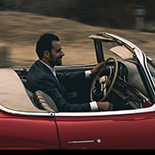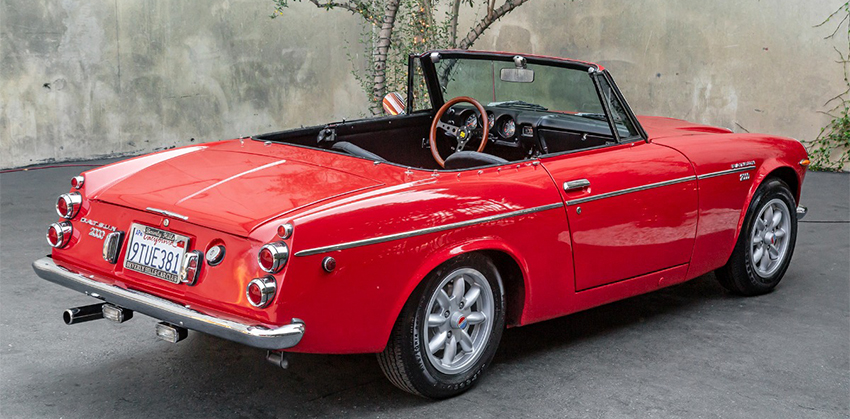The Datsun 2000, such a terrific-looking car:
 0
0
Car Tales: Irresistible, Datsun 2000
A front nose a bit like the Triumph TR4; something of the Mercedes-Benz pagoda-roof about that profile; even looking Ferrari 365-like from some angles; and an overview that can’t help but contain a glimmer of an Austin-Healey 3000.

The Datsun 2000 is such a terrific-looking car: a front nose a bit like the Triumph TR4; something of the Mercedes-Benz pagoda-roof about that profile; even looking Ferrari 365-like from some angles; and an overview that can’t help but contain a glimmer of an Austin-Healey 3000.
And in terms of performance the 2000 beats the contemporary MGB – to which it also has a slight visual affinity – hands-down. Was the thinking behind the look of the Datsun 2000 to evoke so many classics – like a motoring version of a Greatest Hits record – that you wouldn’t be able to resist going out to buy one for yourself? I suspect it may have been: in that great Japanese tradition of taking a bit of the best of everything and making it even better than the source material.
And at the Nissan Shop – as its dealerships were named in Japan – you might be in prestigious company: superstar actor Paul Newman started his car-racing career in a Datsun.
The Datsun Sports (rather fetchingly called Datsun Fairlady in the Japanese and Australian markets and simply given a numerical designation in other markets – hence the Datsun 2000), was a series of roadsters produced by Nissan in the 1960s, and was predecessor to the Z, and offered a solid competitor to the MG, Triumph, Fiat & Alfa Romeo sportscars.
Beginning with the 1959 S211, the line was built in two generations: the first generation was largely hand-built in small numbers, while the second generation (310 series) was series produced. The second generation first appeared in 1961 and continued through 1970 with the SP311 and SR311 lines.
In Japan, it represented one of three core products offered by Nissan at Japanese Nissan dealerships (the aforementioned Nissan Shops), alongside the Datsun Truck and the Bluebird (1000). The second generation Fairlady, called the Datsun 2000 in export, was the two-seat roadster that made their name, fitted with a potent 1,982 cc overhead cam engine with dual SU type side draft carbs and a five-speed transmission.
It is one of these we have right now at Beverly Hills Car Club, a 1969 Datsun 2000 Roadster 5-Speed that is finished in a red exterior combined with a black interior. This classic beauty is a true testament to timeless elegance and exquisite craftsmanship. To further add to the allure of this Roadster, equipped is a convertible soft-top that offers an option for an open-air experience.
Our Datsun 2000 has a 5-speed manual transmission, upgraded with a SR20DE twin-cam 2.0-liter inline-four engine, single exhaust outlet, chrome bumpers with overriders, side curtains, Momo wood steering wheel, Firestone tires, spare tire, and 14-inch alloy wheels. Features amenities include bucket seating, driver-side mirror, an analog clock, and an FM/AM radio.
Whether you’re a seasoned aficionado looking to add a classic to your collection or a vintage car enthusiast seeking a piece of automotive history, this 2000 Roadster is a perfect choice and is mechanically sound.
The introduction of the 1967 SR311 and SRL311 had seen a major update.
Produced from March 1967 until April 1970, the SR311 used a 2.0 L (1,982 cc) U20 engine and offered that five-speed manual transmission, somewhat unexpected for a production car at the time. The inline, four-cylinder U20 engine had a cast iron block and aluminum alloy head.
This new SOHC engine produced, for 1968 to 1970, 135 hp (101 kW; 137 PS) SAE gross in original trim. An optional Competition package included dual Mikuni/Solex carburetors and a special ‘B’ model camshaft for 150 hp (112 kW; 152 PS) SAE gross; the package also provided higher limit gauges and a license plate surround. In Australia there were no emission restrictions at the time and all 2.0-litre cars were fitted with the Competition package as standard.
Cars with the 2.0 liter engine in Japan were regarded as expensive, specialized, sports cars due to the annual local road tax obligation. The Datsun 2000 was lauded as a bargain sports car. It was raced by John Morton, Bob Sharp and others. Its sticker price was lowest in its class, but it won its class in C Production (Mikuni-Solex carburetors) and D-Production (Hitachi-SU carburetors) in SCCA racing on a consistent basis even after production stopped.
Although enthusiasts may claim the first Japanese sports car of significance sold in the U.S. was the Datsun 240Z, you can make a compelling case for the two-seat Datsuns before the 240Z, the Datsun 2000 Sports convertibles – often known as Datsun Roadsters although they were never officially sold as such.
These Datsun 2000s were the first Japanese sports cars that could truly compete with the popular MGs, Triumphs, and Fiats of the day in terms of price and performance.
Unsurprisingly: they were truly fabulous and irresistible cars.
-Alex Manos, Owner

Sell us your car













